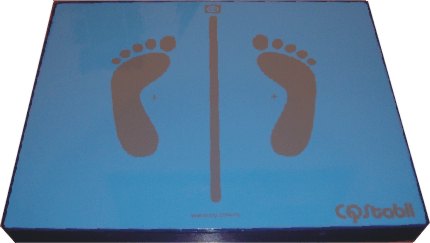Stabilographic platform
CQ-Stabilograph
 The control of body posture and its continuous preservation is a combined process
connected with the central nervous system, sight as well as muscular systems.
The deterioration of efficiency of the balance control system, resulting from an illness
or aging process, leads to reduction of stability, and consequently to falls that can cause serious injuries.
Posturography allows an objective evaluation of patients suffering from balance disturbances
and can be applied in otolaryngology, neurology and geriatrics.
It is used to diagnose patients with a partial damage of balance system
(atrial neuron inflammation, posttraumatic labyrinth damage, Meniere's disease)
as well as patients with central balance disturbances. Posturographic devices can also
be applied for rehabilitation training with patients after traumas and elder patients,
as well as during sport trainings since the information about the state of body posture control system
is very important in case of many disciplines, such as gymnastics, fighting sports, jumps.
The control of body posture and its continuous preservation is a combined process
connected with the central nervous system, sight as well as muscular systems.
The deterioration of efficiency of the balance control system, resulting from an illness
or aging process, leads to reduction of stability, and consequently to falls that can cause serious injuries.
Posturography allows an objective evaluation of patients suffering from balance disturbances
and can be applied in otolaryngology, neurology and geriatrics.
It is used to diagnose patients with a partial damage of balance system
(atrial neuron inflammation, posttraumatic labyrinth damage, Meniere's disease)
as well as patients with central balance disturbances. Posturographic devices can also
be applied for rehabilitation training with patients after traumas and elder patients,
as well as during sport trainings since the information about the state of body posture control system
is very important in case of many disciplines, such as gymnastics, fighting sports, jumps.
Static posturography is an objective evaluation method of the functional condition
of the human balance system where the dislocation of the patient's gravity centre is being observed.
The person under examination stands on a platform with some tensometric sensors located
on its corners recording central pressure of the patient's feet on the ground
(projecting the centre of gravity on the base surface), as well as its dislocation
in the sagittal axis X, i.e. left-right and frontal axis Y, i.e. forward-backward.
The projection of the centre of feet pressure is recorded as a point as well as
a dynamic parameter that changes its location within a time unit.
Statokinesiometric tests are carried out first with open eyes, and than with the eyes shut.
 The examination results are represented in forms of diagrams called statokinesiogram or stabilogram:
The examination results are represented in forms of diagrams called statokinesiogram or stabilogram:
·
Statokinesiogram
depicts the movement of pressure centre in coordinate system in which the axis x refers to swingings
in direction right - left, and the axis y - to swingings in direction forward - backward.
·
Stabilogram
represents the location of pressure centre as a time function whereas the movements
in direction right - left and forward - backward are considered separately.
Moreover on the basis of the examination results following parameters are calculated:
·
L -
length of statokinesiogram outlined by the feet pressure centre CoP (in mm);
·
S –
size of surface outlined by the feet pressure application point
(in mm2);
·
L/S
length of statokinesiogram in relation to the size of surface (1/mm);
·
V -
average speed of dislocation of feet pressure centre in compound motion
as well as in frontal and sagittal plane (mm/s);
·
LW-F –
number of deflections CoP in the frontal plane;
·
LW-S –
number of deflections CoP in the sagittal plane;
·
Max-F
maximum deflection in the frontal plane as well as Max-S in the sagittal plane;
·
Staying time in "areas" with different, set size (diameter).
For parameters L, S, L/S, V Romberg coefficient is calculated which constitutes
the relation of the size of parameters received in the tests carried out with
the patient's eyes open to the size of parameters received
in the tests carried out with the patient's eyes shut.
The software of posturograph allows:
·
watching obtained parameters during a test/an exercise;
·
storing results after examination completion;
·
optional representation of data on computer screen in form of cartesian coordinates, circles,
squares with the possibility of changing the scale of representation;
·
obtaining integrated graphical and numeric reports;
·
conversion of examination results as well as courses of deflection in both axis
- in ASCII format into statistic packets or worksheets.